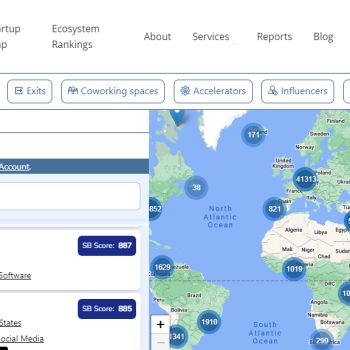Startup accelerator programs are pivotal in sculpting the future of startup ecosystems, which in turn fuels the growth of local economies. However, accurately measuring their performance poses significant challenges due to the diversity of objectives across programs. It is here that StartupBlink steps in, providing comprehensive solutions for measuring the impact of startup accelerator programs, irrespective of whether they are operated by the public or private sector. This article explores the methodologies employed in measuring the startup accelerator programs’ performance and highlights the critical nature of tailoring metrics to align with the specific objectives of each program.
As a research center specializing in innovation economy insights, StartupBlink employs a multi-dimensional analysis approach, combining quantitative data on funding rounds, startup growth metrics, and qualitative surveys from program participants and stakeholders. This holistic view enables a nuanced understanding of an accelerator’s impact. To learn more about assessing the startup accelerator program performance, contact us.
Understanding the Goals of Accelerator Programs
Evaluating the performance of startup accelerator programs necessitates a deep understanding of their underlying objectives. These goals can differ between accelerators operating within the private sector and those associated with public or governmental initiatives. Each sector targets distinct outcomes, reflecting their unique roles in the startup ecosystem. Here, we dissect the objectives of accelerator programs within these two sectors, highlighting their diverse aims and the implications for performance measurement.
Read more about the top startup accelerator and programs in this article.
Private Sector Accelerator Goals
Private sector accelerators are typically driven by a blend of strategic and financial objectives. Their goals often revolve around:
- Supporting Open Innovation: Private accelerators aim to foster innovation by facilitating collaboration with startups. This approach not only helps startups scale but also enables larger corporations to integrate new technologies and innovative solutions into their operations.
- Gaining New Clients: By nurturing startups, private accelerators often seek to build long-term business relationships. Successful startups may become key clients or partners, contributing to the accelerator’s economic objectives.
- Venture Investment: Some private accelerators are closely linked with venture capital, aiming to identify and invest in high-potential startups.
- Market Positioning: Private accelerators also aim to enhance their brand’s position in the industry. By associating with innovative startups, they can boost their reputation as leaders in innovation and entrepreneurship.
Public Sector Accelerator Goals
Public or governmental accelerators, on the other hand, tend to focus on broader economic and social objectives:
- Fostering Industry-Specific Innovation: Public accelerators may target specific sectors where innovation is seen as key to national or regional economic development. Their goal is to stimulate growth and competitiveness within these sectors.
- Supporting Startups to Reach Market Readiness: Public accelerators often prioritize helping startups refine their products or services to meet market demands, thereby increasing their chances of success.
- Increasing the Survival Rate of Local Startups: A critical objective for public accelerators is to bolster the local startup ecosystem by enhancing the survival and growth rates of new ventures. This, in turn, can lead to job creation and economic diversification.
- Facilitating Access to Investment Opportunities: Public sector programs may also focus on bridging the gap between startups and potential investors, including both public and private funding sources, to ensure that emerging companies have the capital they need to grow.
How to Measure Startup Accelerator Program Performance?
Evaluating the performance of startup accelerator programs is crucial for ensuring their continued effectiveness and contribution to the entrepreneurial ecosystem. With a variety of challenges such as differing program durations, the wide range of industries startups operate in, and the qualitative nature of certain objectives, finding the right Key Performance Indicators (KPIs) is essential. StartupBlink, with its unique approach and comprehensive methodology, offers insightful ways to measure accelerator program performance.
1. Ecosystem Impact Analysis
To measure the impact of an accelerator, it’s vital to assess its influence on the ecosystem, market entry, brand perception, and corporate impact. This involves a detailed comparison with top-tier accelerators and an evaluation of the program’s growth, innovation, and partnership metrics. By quantifying the accelerator’s role in fostering ecosystem growth, one can gain a clear understanding of its effectiveness.
StartupBlink uses an algorithmic ranking combined with program-specific KPIs, targeted surveying tools, and comprehensive ecosystem analysis to offer strategic insights. This approach allows for an understanding of an accelerator’s impact on the startup ecosystem.

2. Startup Scoring & Recruitment Strategy Review
A critical review of the accelerator’s startup selection and recruitment strategies is essential. This includes a retrospective evaluation of recruitment success, recommendations for refined approaches, and an emphasis on identifying overlooked opportunities (anti-portfolio analysis).
Through algorithmic startup ranking and strategic insights, StartupBlink evaluates the recruitment approaches of an accelerator. This adaptability ensures the accelerator remains relevant in the evolving startup ecosystem.

3. Cohort Survey Assessment
Conducting surveys before and after each cohort is pivotal. These surveys measure startups’ growth trajectory and founder feedback, translating into a Net Promoter Score (NPS) that serves as a critical indicator of the program’s effectiveness.
With a focus on dual-timeline assessment and direct founder feedback, StartupBlink’s methodology offers a comprehensive evaluation of program impact on startup development and founder satisfaction by combining both quantitative and qualitative measures.

To Sum Up,
Measuring the performance of startup accelerator programs is multifaceted, requiring a careful consideration of the program’s objectives, the value it provides to participants, and its overall impact on the startup ecosystem. While the frameworks and KPIs outlined provide a foundation for measuring accelerator performance, these methodologies must evolve alongside the startup ecosystems they aim to support. Continuously refining these metrics will ensure accelerator programs can effectively drive startup success and contribute to economic growth
As a research center with data on over 150,000 startups across 12 industries, 1,000 cities, and 100 countries’ startup ecosystems, StartupBlink offers a unique way to assess your startup program’s performance, supporting strategic decision-making and better communication of program results.







